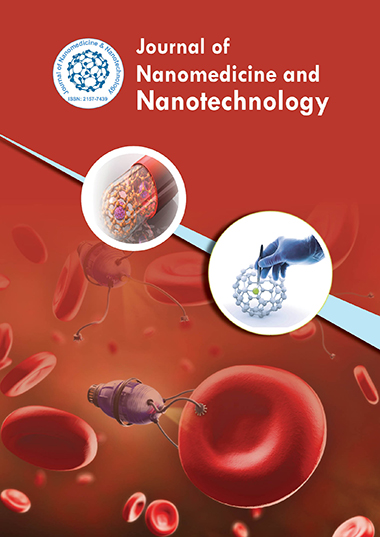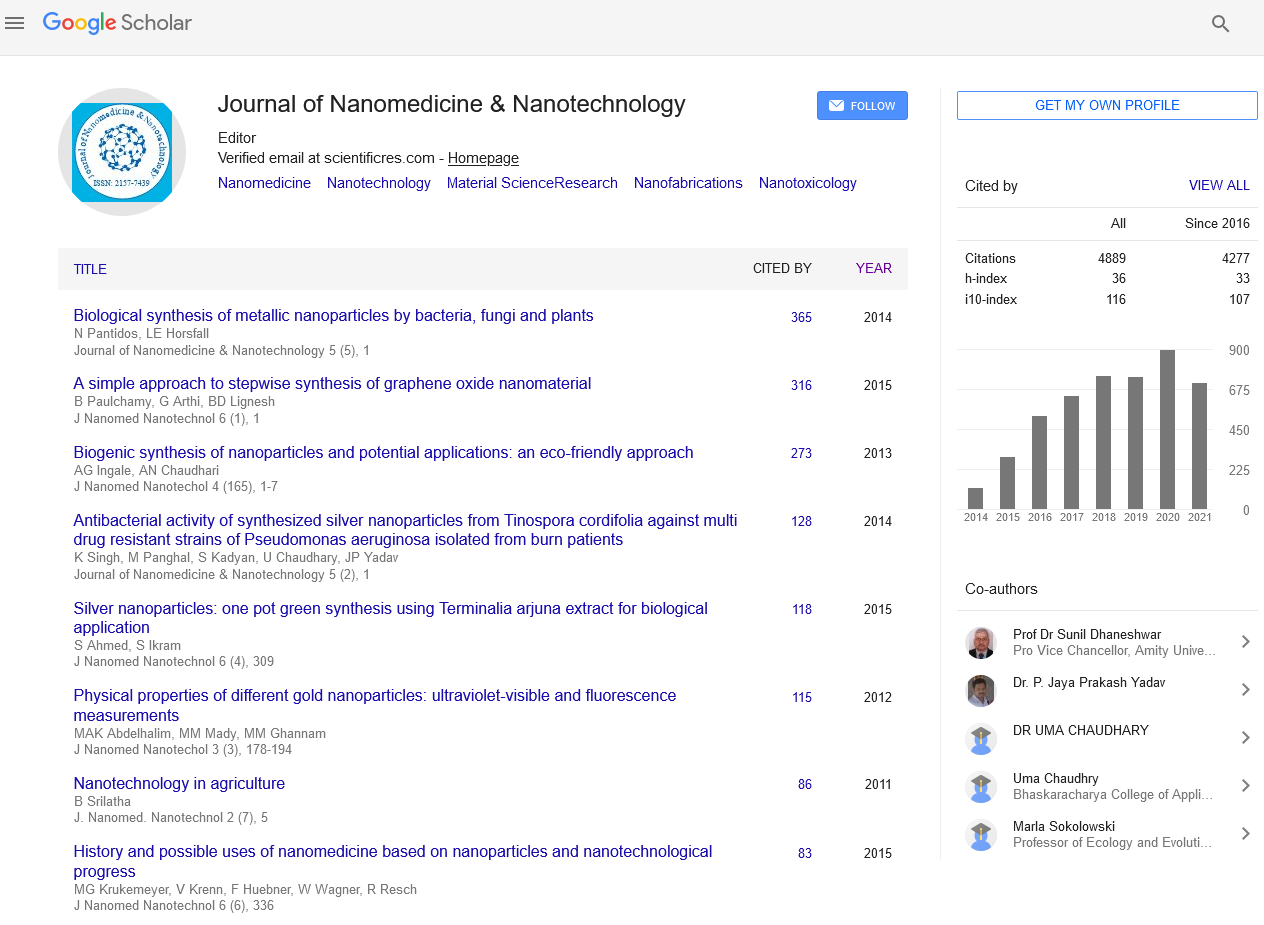Indexed In
- Open J Gate
- Genamics JournalSeek
- Academic Keys
- JournalTOCs
- ResearchBible
- China National Knowledge Infrastructure (CNKI)
- Scimago
- Ulrich's Periodicals Directory
- Electronic Journals Library
- RefSeek
- Hamdard University
- EBSCO A-Z
- OCLC- WorldCat
- SWB online catalog
- Virtual Library of Biology (vifabio)
- Publons
- MIAR
- Scientific Indexing Services (SIS)
- Euro Pub
- Google Scholar
Useful Links
Share This Page
Journal Flyer

Open Access Journals
- Agri and Aquaculture
- Biochemistry
- Bioinformatics & Systems Biology
- Business & Management
- Chemistry
- Clinical Sciences
- Engineering
- Food & Nutrition
- General Science
- Genetics & Molecular Biology
- Immunology & Microbiology
- Medical Sciences
- Neuroscience & Psychology
- Nursing & Health Care
- Pharmaceutical Sciences
Opinion Article - (2025) Volume 16, Issue 2
Nanobiopharmaceutics: Enhancing Bioavailability and Targeted Therapy
Astrid Vargstrom*Received: 01-Mar-2025, Manuscript No. jnmnt-25-28603; Editor assigned: 05-Mar-2025, Pre QC No. jnmnt-25-28603 (PQ); Reviewed: 20-Mar-2025, QC No. jnmnt-25-28603; Revised: 25-Mar-2025, Manuscript No. jnmnt-25-28603 (R); Published: 31-Mar-2025
Abstract
Nanobiopharmaceutics is an emerging field that integrates nanotechnology with pharmaceutical sciences to develop advanced drug delivery systems that improve bioavailability and therapeutic efficacy. By utilizing nanoparticles, liposomes, and polymeric carriers, this field enables precise targeting of diseased cells, reduces side effects, and enhances drug stability. Recent innovations in nanobiopharmaceutics have led to significant advancements in controlled drug release, personalized medicine, and treatment strategies for chronic diseases such as cancer and neurodegenerative disorders. However, challenges such as toxicity, regulatory concerns, and scalability must be addressed to ensure the successful translation of nanobiopharmaceuticals from research to clinical applications. This article explores key innovations, benefits, challenges, and future directions in nanobiopharmaceutics.
Keywords
Nanobiopharmaceutics; Nanotechnology; Drug delivery; Bioavailability; Targeted therapy; Nanoparticles; Liposomes; Controlled release; Personalized medicine; Pharmaceutical innovation
INTRODUCTION
The field of nanobiopharmaceutics represents a paradigm shift in drug development and delivery, combining the principles of nanotechnology and pharmaceutical sciences to enhance therapeutic effectiveness. Traditional drug formulations often face challenges such as poor solubility, low bioavailability, and systemic side effects. Nanobiopharmaceutics addresses these issues by employing nanoscale carriers that improve drug solubility, stability, and targeted delivery. The ability to design drug delivery systems that release medication at a controlled rate and in a specific location has led to breakthroughs in treating complex diseases, including cancer, cardiovascular disorders, and neurological conditions. This article examines the innovations in nanobiopharmaceutics that are shaping the future of medicine [1,2].
DESCRIPTION
Nanobiopharmaceutics leverages various nanocarriers, including nanoparticles, liposomes, dendrimers, micelles, and polymer-based systems, to optimize drug delivery. These carriers enhance bioavailability by protecting drugs from degradation, promoting cellular uptake, and enabling sustained release. For instance, lipid-based nanoparticles, such as liposomes, have been widely used to encapsulate hydrophobic drugs, ensuring better absorption and prolonged circulation in the body. Polymeric nanoparticles allow for biodegradable and biocompatible drug delivery systems that minimize toxicity while maximizing therapeutic benefits [3,4].
One of the most promising advancements in this field is the development of targeted drug delivery systems. By functionalizing nanoparticles with ligands, antibodies, or peptides, drugs can be directed to specific cells or tissues, minimizing off-target effects. This approach has proven particularly beneficial in oncology, where targeted nanoparticles can selectively accumulate in tumor sites, improving drug efficacy while reducing damage to healthy tissues. Additionally, nanocarriers are being explored for gene therapy, enabling the precise delivery of genetic material for treating inherited diseases and cancers [5,6].
DISCUSSION
Despite the remarkable potential of nanobiopharmaceutics, several challenges hinder its widespread adoption. One of the primary concerns is the potential toxicity of nanomaterials. Due to their small size and high surface reactivity, nanoparticles can accumulate in organs and exhibit unintended biological interactions, necessitating extensive biocompatibility studies. Addressing these concerns requires rigorous preclinical and clinical testing to establish safety profiles and regulatory approval [7].
Another critical challenge is the large-scale production and commercialization of nanobiopharmaceuticals. The complexity of nanomaterial synthesis, formulation stability, and reproducibility pose significant hurdles for mass production. Standardization of manufacturing processes and regulatory frameworks is essential to ensure the consistency and quality of nanomedicines [8,9].
Furthermore, the cost of developing nanobiopharmaceuticals remains a barrier to accessibility. Advanced nanocarrier systems require specialized equipment, materials, and expertise, making them expensive to produce. Bridging the gap between cutting-edge research and affordable healthcare solutions is crucial for making nanobiopharmaceutics a viable option for widespread clinical use [10].
CONCLUSION
Nanobiopharmaceutics is revolutionizing the pharmaceutical industry by enhancing drug bioavailability, enabling targeted therapy, and improving patient outcomes. Innovations in nanocarriers, controlled drug release, and personalized medicine have paved the way for more effective treatments with reduced side effects. However, challenges related to toxicity, regulatory approval, and cost must be overcome to facilitate broader clinical adoption. Future research should focus on developing safer, cost-effective, and scalable nanopharmaceutical solutions to maximize the benefits of this groundbreaking field. As nanobiopharmaceutics continues to evolve, it holds the potential to transform modern medicine and provide novel therapeutic strategies for some of the most challenging diseases.
ACKNOWLEDGEMENT
None
CONFLICT OF INTEREST
None
REFERENCES
- Sutradhar K B, Sumi C D, Al-Mahmood A K. DPPH free radical scavenging activity of some Bangladeshi medicinal plants. Journal of Acute Disease. 2014; 3(3):182-185.
- Huang B, Abraham W D, Zheng Y, Bustamante Lopez S C. Breaking Through Tumor Hypoxia: Developing Hypoxia-Targeting Nanoparticles. Crit Rev Ther Drug Carr Syst. 2018; 35(5): 433-469.
- Burrell R A, McGranahan N, Bartek J, Swanton C. The causes and consequences of genetic heterogeneity in cancer evolution. Nature. 2018; 501(7467): 338-345.
- Tong R, Chiang, H H, Kohane D S. Photoswitchable nanoparticles for in vivo cancer chemotherapy. Proceedings of the National Academy of Sciences. 2019; 110(46): 19048-19053.
- Dong Y, Li Z, Zhou J. A new class of biocompatible and luminescent carbogenic nanodots for bioimaging. Chemical Communications. 2020; 46(46): 2761-2763.
- Soe Z C, Thapa R K, Ou W, Gautam M, Nguyen, H T, Jin et al. Folate receptor-mediated celastrol and irinotecan combination delivery using liposomes for effective chemotherapy in colorectal cancer mouse xenografts. Journal of Controlled Release.2019; 303: 1-15.
- Yao V J, D'Angelo S, Butler K S, Theron C, Smith T L, Marchio S, et al. Ligand-targeted theranostic nanomedicines against cancer. Chemical Reviews. 2016; 116(6): 3436-3486.
- Balasubramanian P, Yang L, Lang J C, Jatana K R, Schuller D. Aloe-emodin induces chemo-radiosensitivity in human hepatocellular carcinoma cells via modulating p53-mediated apoptosis. J Exp Clin Cancer Res. 2014; 33(1): 1-14.
- Brown, D M, Donaldson K, Stone V, Clouter A. The effects of PM10 particles and oxidative stress on macrophages and lung epithelial cells: modulating effects of calcium signalling agonists and antagonists. Thorax. 2020; 58(4): 271-279.
- Gupta A, Kumar R, Jha A. Preparation, characterization, and application of magnetic nanoparticles for gene delivery and imaging. Journal of Nanoparticles. 2019; 2013: 1-14.
Indexed at, Google Scholar, Crossref
Indexed at, Google Scholar, Crossref
Indexed at, Google Scholar, Crossref
Indexed at, Google Scholar, Crossref
Indexed at, Google Scholar, Crossref
Indexed at, Google Scholar, Crossref
Indexed at, Google Scholar, Crossref
Citation: Astrid V (2025) Nanobiopharmaceutics: Enhancing Bioavailability and Targeted Therapy. J Nanomed Nanotech. 16: 779.
Copyright: ©2025 Astrid V. This is an open-access article distributed under the terms of the Creative Commons Attribution License, which permits unrestricted use, distribution, and reproduction in any medium, provided the original author and source are credited.


